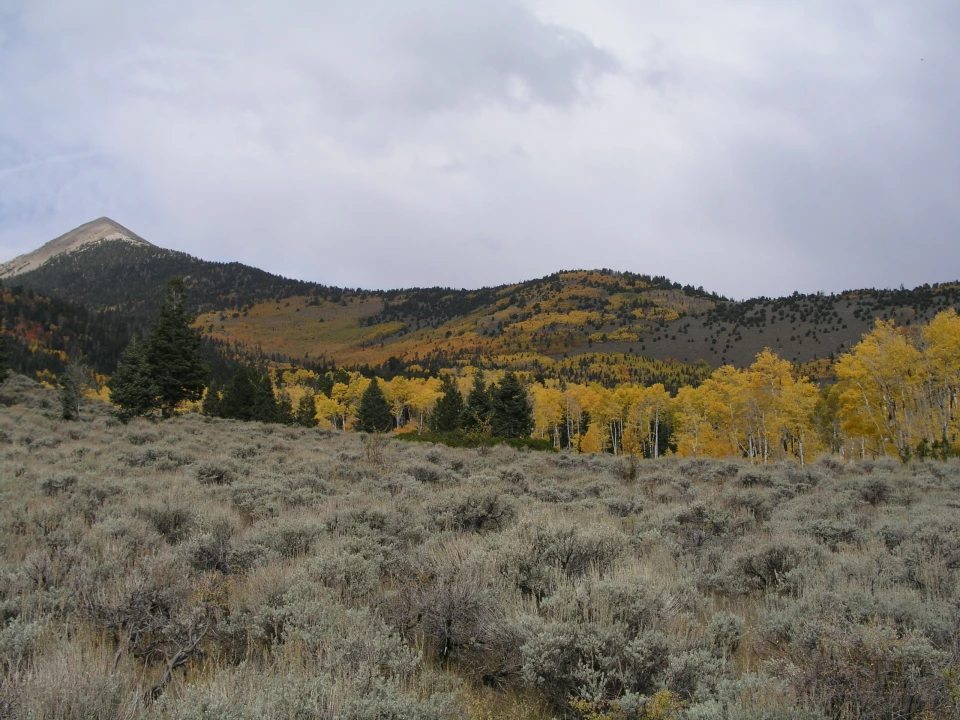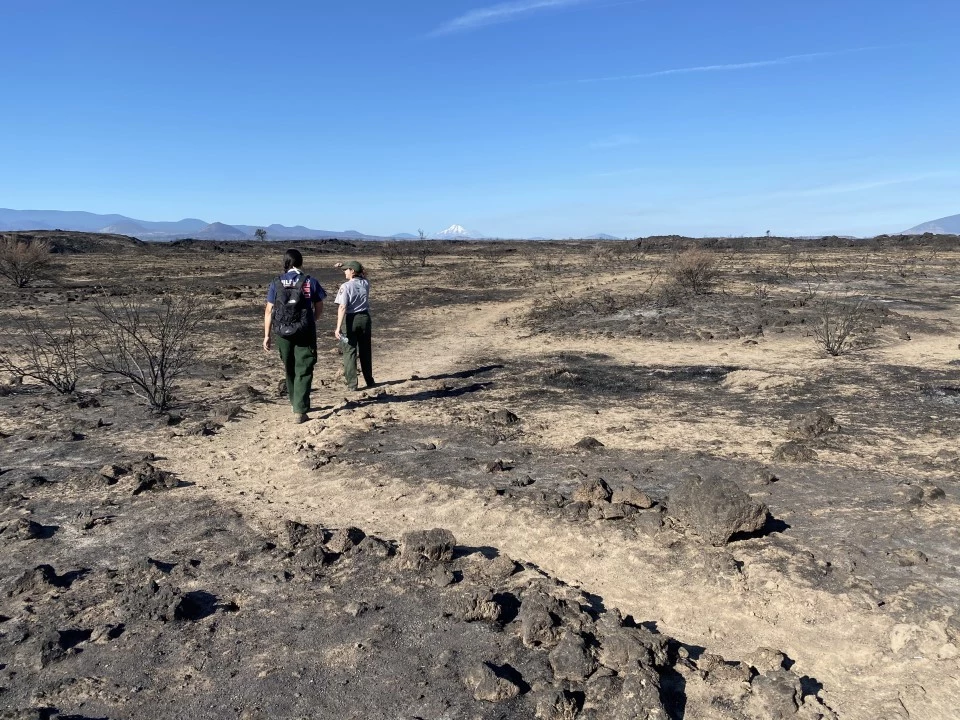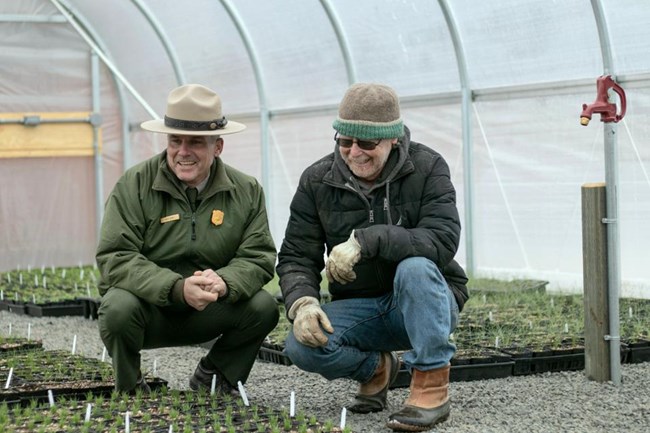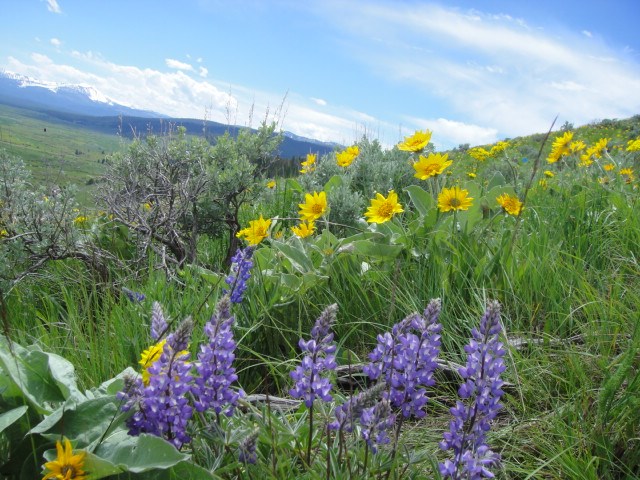Last updated: August 16, 2024
Article
NPS Establishes NPSage Initiative to Restore Sagebrush-Steppe Ecosystems
In the northern part of Craters of the Moon National Monument and Preserve, the songbirds sing at sunrise, and the wind blows through the fields of sagebrush sprinkled with yellow balsamroot, red paintbrush, and purple lupine, indicating a healthy sagebrush ecosystem. Au contraire, in Lava Beds National Monument, ash and dirt is all that remains following a devastating wildfire. The rainbow of wildflowers is gone and cheatgrass, an invasive annual grass, has crept in where the sagebrush used to thrive as silence echoes where the songbirds once sang. Visitors can witness what has happened in Lava Beds National Monument in other national parks that have experienced sagebrush loss to wildfire.
Artemisia species, commonly known as sagebrush, are far from being the only species on the landscape. The sagebrush biome is composed of a rich mosaic of thousands of diverse plant species, which are largely driven by differences in climate, soil and elevation. These distinct sagebrush plant and animal communities occur in approximately 70 park units across the western U.S— all of which are experiencing significant threats from wildfire and droughts. “In the National Park Service, we have 3 million acres of sagebrush and all of it is being threatened by fire-driven loss of existing sagebrush. After a wildfire, invasive annual grasses grow more quickly, replacing the native sagebrush ecosystems,” Tom Rodhouse, NPS ecologist, said. “There are many different troublesome invasive species, but cheatgrass is among the most well-known and widespread.”
Sagebrush is an important species for carbon storage. When it burns it releases high amounts of carbon into the atmosphere and no longer supports carbon storage in the soil. “The fire-annual grass cycle is a climate change problem and an adaptation opportunity,” Rodhouse said. “Annual grasses and cheatgrass in particular, provide fine fuels to drive new fire behavior, so that the more fire you have, the more annual grass you have, and so-on in a vicious cycle accelerating with climate change.”


Left image
Pristine Sagebrush-Steppe biome adjacent to autumn Aspen groves in Great Basin National Park
Credit: NPS Photo
Right image
NPS staff inspecting post-wildfire damage in Lava Beds National Park
Credit: NPS Photo
The NPS is using the resist-accept-direct (RAD) framework to prepare for future climate conditions and is adaptively managing in landscapes that are succumbing to the fire-annual grass cycle. It turns out that some sagebrush landscapes are more resilient to wildfire and grass invasion than others, and NPS is using these scientific insights to prioritize conservation. “The higher colder sagebrush sites tend to be the places where we have the best remaining sagebrush ecosystems and the best chances of conservation success, compared to the lower-elevation, hotter and drier ecosystems, so those are the ones we need to urgently protect before they degrade further,” Rodhouse said.
The RAD framework helps NPS and others think through and optimize actions by considering interactions among factors including climate change, land use, nonnative species, and other ecosystem changes that are contributing to sagebrush loss, cast in terms of where and why specific conservation strategies will be more successful than others. The framework also encourages collaboration with other agencies and being more open to new research methods and processes.
The “R” in RAD, the concept of resisting change, describes actions to protect and defend the landscapes, such as through fire breaks. “We do this by trying to introduce fire breaks or other ways to mitigate fire impacts,” he said. To “accept” is to think about landscapes that have already been burned and are stuck in the fire-annual grass cycle. “We must accept some losses in landscapes,” Rodhouse said. “It doesn’t mean we are just walking away; we just need to be more creative in how we work with those landscapes.” According to Rodhouse, for example, old agricultural fields are being converted to growing native bunchgrasses for restoration seed supply and fire breaks are being placed within degraded areas to protect adjacent intact areas. “Direct” means exploring new opportunities such as assisted migration and integrated restorative actions for landscapes to be more resilient for future climate conditions.

NPS Photo
The NPSage initiative was originally established by the National Park Service in the Pacific West Region and has since expanded to a biome-wide approach across two regions. The NPSage initiative has received funds from the Bipartisan Infrastructure Law in order to build climate resilience and increase biodiversity in high-priority sagebrush ecosystems. The Bipartisan Infrastructure Law has helped to implement the National Seed Strategy and increase access to resources for ecosystem restoration.
There is not a simple process on how to reintroduce native plants after wildfire devastation or to combat exotic plant invasions. “We have to consider a lot of factors like where to get native plant seeds, are they the right species for a particular ecosystem, were they collected from the appropriate environment, is it even possible to plant those seeds in an adapted environment,” Rodhouse said. “With Bipartisan Infrastructure Law funding, now we can implement the National Seed Strategy and more efficiently and effectively restore landscapes after a fire.”
Why save the sagebrush?
Like in Big Hole National Battlefield and Fort Laramie National Historic Site, sagebrush landscapes in the National Park system may also be designated as cultural landscapes due to their historical significance. The Cultural Resource division within the NPS manages and operates the process of designating landscapes as cultural landscapes. “In many cases, these sagebrush landscapes are important places of American history,” Rodhouse said.
NPS Photo
Sagebrush is also important to indigenous tribes. “Many of the plants in sagebrush-steppe ecosystems have been and remain important crops for indigenous people,” Rodhouse said. “For example, biscuit root and pinyon pine nuts continue to be harvested by many families with tribal affiliations in sagebrush ecosystems.” According to Rodhouse, NPSage creates better opportunities for NPS to collaborate directly with tribal partners to collect seed and propagate native plant materials for use in the restoration of these imperiled ecosystems.
The NPSage initiative is an educational opportunity to share the work with park visitors on the importance of fulfilling the NPS mission to preserve natural and cultural resources for the enjoyment of this and future generations. “Visitors will see the good and the bad—they’ll see the burned landscapes, the annual grass-infested landscapes,” Rodhouse said. “More importantly, they’ll see the work that is being done by crews and they’ll have opportunities to have conversations and learn about the work that the Bipartisan Infrastructure Law is funding.” According to Rodhouse, this is a groundbreaking level of collaboration specific to the sagebrush-steppe ecosystem. “We are going to be implementing effectiveness monitoring which we have not invested in yet to determine whether our actions are successful,” he said.
Tags
- big hole national battlefield
- black canyon of the gunnison national park
- city of rocks national reserve
- craters of the moon national monument & preserve
- curecanti national recreation area
- fort laramie national historic site
- grand canyon-parashant national monument
- grand teton national park
- great basin national park
- hagerman fossil beds national monument
- john day fossil beds national monument
- lake roosevelt national recreation area
- lava beds national monument
- bipartisan infrastructure law
- ecosystems
- ecosystem restoration
- inflation reduction act
- ucbn
- upper columbia basin network
- npsage
